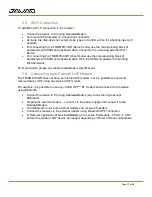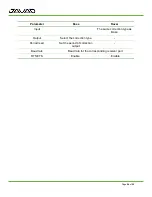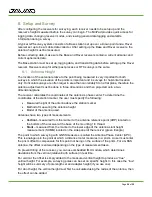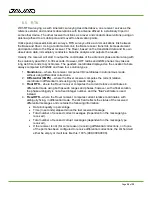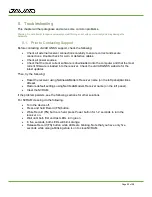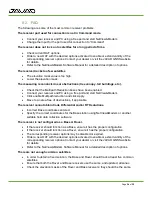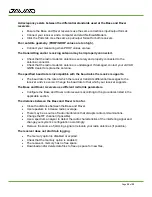
Page
26
of
35
6. Setup and Survey
After configuring the receivers for surveying, each receiver needs to be setup up and the
receiver’s height measured before the survey can begin. The MinPad provides quick access for
logging data, changing receiver modes, and viewing general data logging and satellite
information during a survey.
A typical GPS survey system consists of a Base station set up over a known point and a Rover
receiver set up to be a mobile data collector. After setting up the Base and Rover receivers, the
antenna height must be measured.
Before collecting data, make sure the Base and Rover receivers contain a current almanac and
current ephemeris data.
The Base station must be set up, logging data, and transmitting data before setting up the Rover
receiver. Receiver setup for either post-process or RTK surveys is the same.
6.1. Antenna Height
The location of the antenna relative to the point being measured is very important for both
surveys in which the elevation of the points is important and in surveys for horizontal location
only. Horizontal surveys are often larger in area than can reliably fit on a flat plane, therefore the
antenna adjustment must be done in three dimensions and then projected onto a two-
dimensional plane.
The receiver calculates the coordinates of the antenna’s phase center. To determine the
coordinates of the station marker, the user must specify the following:
•
Measured height of the antenna above the station marker
•
Method of measuring the antenna height
•
Model of the antenna used.
Antennas have two types of measurements:
•
Vertical
– measured from the marker to the antenna reference point (ARP) located on
the bottom of the receiver at the base of the mounting 1/4 thread.
•
Slant
– measured from the marker to the lower edge of the antenna slant height
measure mark (SHMM) located on the side panel of the receiver (green triangle).
The point to which surveying with GNSS measures is called the Antenna Phase Center (APC).
This is analogous to the point at which a distance meter measures in a prism. A user must enter
the prism offset to compensate for this point not being on the surface of the prism. For a GNSS
antenna, the offset is entered depending on the type of measurement taken.
To prevent tilting of the receiver, you can use embedded IMU module, which determines
deviations from the vertical (relative Earth surface) in real time.
For vertical, the offset is simply added to the measured vertical height to produce a “true”
vertical height. For example, surveying poles can be set on specific height. In this case the “true”
height will be summary of pole length set and adapter height (if you use one).
For slant height, the vertical height must first be calculated using the radius of the antenna, then
the offset can be added.






